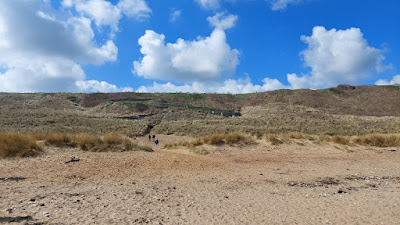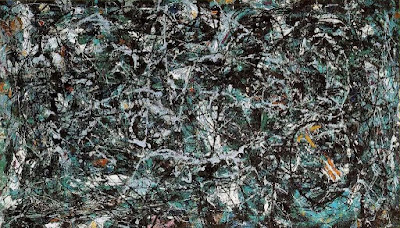
Thirty- five minutes of backwards songs.
This mix occurred to me a few weeks ago when I posted David Holmes’ remix of Andy Bell’s The Sky Without You, a remix of the opening song from Andy’s 2022 solo album Flicker. Reversing the tapes and playing them backwards is an age old technique- The Beatles used it in 1966 on Rain and then perfected it on Tomorrow Never Knows (although both of those merely contain backwards elements/ instruments- most of what’s included below is entirely backwards). They went the full hog on the white album with Revolution 9. Those backwards noises- the sound of cymbals splashing in reverse, the trippy whirl of guitars backwards, the weird throb of bass- are all very evocative and possibly suggest too long spent in the studio, indulgence maybe, but when done well are superb. I’ve loved it as a sonic whoosh, an aural WTF?, since my first exposure to The Stone Roses and their B-sides in 1989 and Don’t Stop. This mix will I suspect be an opinion splitter- you’ll either roll your eyes and quietly close the page and go elsewhere for your Sunday morning music fix or you’ll love this. I’ve played it through several times and each time can convince myself it’s the best Sunday mix I’ve ever done.
xiM sgnoS sdrawkcaB fO setuniM eviF- ytrihT
- Andy Bell: The Sky Without You
- The Stone Roses: Simone
- The Clash: Mensforth Hill
- The Stone Roses: Previously Unheard Backwards Track 3
- The Stone Roses: Full Fathom Five
- Andy Bell: The Looking Glass
- Andy Bell: The Sky Without You (David Holmes Radical Mycology Remix)
- The Stone Roses: Guernica
- The Stone Roses: Don’t Stop
The Sky Without You opens Flicker, Andy Bell’s solo album. It was a deliberate nod to The Stone Roses, Andy looking backwards to Don’t Stop and the B-sides of Elephant Stone, Made Of Stone, and She Bangs The Drums. Most of the rest of Flicker is fully crafted, ‘proper’ songs, from the lovely Something Like Love to the wistful Way Of The World. Halfway through, the start of the second disc on the vinyl version, is another backwards track, The Looking Glass, Andy’s voice, guitar and what sounds like some organ fed backwards through the looking glass. I’m guessing it’s one of the songs from Flicker flipped.
Simone is Where Angels Play played backwards and for many years was only available as the B-side of a U.S. import version of I Wanna Be Adored, which found its way into U.K. shops in 1989. It was buying this 12″ single for this one song, a 12″ priced at £5.99 (a huge amount for a 12″ single then) that made me realise I was in deep. Where Angels Play was the ‘lost’ song from the golden period of 1989- 1990, the song that didn’t make the album but was often bootlegged live. It was eventually released on a 12″ of I Wanna Be Adored, put out by Silvertone as a money spinner when the band and label were in dispute- a dispute that led to a court case that led to the band signing to Geffen and to the end of the group ultimately.
By the time The Clash had committed themselves to an album which would comprise six sides of vinyl and to having six songs for each side, they were in very deep indeed. Studio experimentation, Joe’s lyric writing bunker, and hours through the night of recording dubs and versions with Mikey Dread were the order of the day. I’ve said it before and I’ll say it again- London Calling may be their ‘best’ album, punk purists will go for the debut, some of the class of ’78 will always argue for Give ‘Em Enough Rope, but Sandinista! is where the true, questing spirit of The Clash is to be found. It’s a treasure trove and as Joe says in Westway To The World, it’s ‘a magnificent achievement, warts and all’. Mensforth Hill is Something About England played backwards with studio chatter at both ends. ‘Shall we do another one then?’ asks Joe at the end. Yes please!
Previously Unheard Backwards Track 3 is She Bangs The Drums played in reverse- it came out as an extra on the 20th anniversary release of The Stone Roses (the one with the lemon shaped USB stick- no, I didn’t buy it).
Full Fathom Five (a nice coincidental link to Duncan Gray’s album Five Fathoms Full that came out last week) is Elephant Stone backwards (the Peter Hook produced version of Elephant Stone, so if you can reverse the reversed version, you’ve got Hooky’s mix of the song too). I think this is a little more than just flipping the tape round- Ian’s vocals are unclear but recorded and dropped in forwards. Full Fathom Five is the name of a 1947 Jackson Pollock painting, one of his earliest drip paintings, a masterpiece, and a clear influence on John Squire’s Roses sleeve art from this period.

The Sky Without You has already appeared once here. For his Radical Mycology Remix David Holmes took all of Andy’s backwards Roses swirl and took it further, adding forwards drums, a blurry sunny day feel and sirens. One of my favourite records of recent years. David’s name for the remix came from some mushroom based experimentation he undertook during lockdown, dealing with some growing up in Belfast related PTSD
Guernica is Made Of Stone backwards with Ian singing a new vocal forwards- ‘If you wanna hurt me stop the row’ (or similar), can be made out fairly clearly. This one feels like a step towards Don’t Stop. You can imagine them in the studio with John Leckie working their way through the songs backwards, hitting on certain ones, trying new vocals, flipping parts around and eventually getting it all together when they reversed Waterfall. There was an interview with Ian and John in ’88 or ’89 where they said they used to drive out the road under the flightpath at Manchester airport (I know exactly which road they mean too), sit on the bonnet of the car and wait for the jumbo jets to take off over head, and then try to replicate the roar of the engines with their reversed tapes. Guernica is a painting by Pablo Picasso, depicting the Spanish town that was obliterated by the Nazi’s Condor Legion, Stuka dive bombers deployed to aid the fascists in the Spanish Civil War. 2024; see Gaza.
A Spanish Civil War Sunday mix anyone?
Don’t Stop is more and more, as each year passes, the highlight of The Stone Roses debut album- don’t laugh- the one where the experimentation, delight in backwards tapes, a modern psychedelic guitar band was fully realised. Reni’s drums and Ian’s vocals are both forwards, recorded over Waterfall played in reverse. There’s more to it than just reversing the tape- the guitars are slowed down, sounding like an actual waterfall, and the fade in has been added from elsewhere. Things are out of sync. The flow of the backwards guitars and bass, bubbling, lightly drilling, is a rush and Reni’s cowbell tapping away gives so much. John wrote the lyrics by listening to Ian’s vocal for Waterfall played backwards and then transcribed what Ian’s blurred voice seemed to be suggesting.Ian then sang them- the lyrics are among the best too- ‘hey blues singer/ just the guitar/ from the top/ what can I steal/ what can I feel/ I wake/ ease into my heart/ one of us/ don’t stop/ isn’t it funny how you shine?’. Andy Bell used this technique on Flicker. Which is where we came in….
Filed under: Uncategorized | Tagged: andy bell, david holmes, ian brown, jackson pollock, john leckie, john squire, The Clash, the stone roses | Leave a comment »








